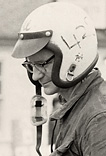 Even though enduro competition had been part of motorcycling in America from the earliest days of the AMA and its predecessors, enduro riding as it’s known today was a long time in the making. One man who was close to the evolution of the sport for most of his adult life was Al Eames.
Even though enduro competition had been part of motorcycling in America from the earliest days of the AMA and its predecessors, enduro riding as it’s known today was a long time in the making. One man who was close to the evolution of the sport for most of his adult life was Al Eames.
Eames was a driving force behind getting the United States involved in international off-road competition such as the International Six Day Trials (now known as International Six Day Enduro). Eames helped bring the ISDT to the United States for the first time in 1973. For years, Eames was the man primarily responsible for putting on many of the top enduro events in New England during the 1960s, including the renowned Berkshire Trials. He came to work for the AMA in the early-1970s and helped many riders across the country establish off-road clubs.
Eames was born on October 11, 1927 in Pittsfield, Massachusetts. He came to motorcycling in the late 1950s and loved to ride off road in the hilly trails of western Massachusetts. He became involved the Greylock Riders motorcycle club and started competing in various off-road events. As a competitor, Eames described himself as a “no star among A riders”. As a member of the club, Eames volunteered to help lay out the enduro courses and found he enjoyed that activity even more than riding. Before long, Eames was the primary organizer of the club’s off-road races.
Eames had a real talent for reading topographical maps and laying out challenging courses. To lay out often hundreds of miles of trails, Eames also had to have the gift of winning people’s confidence. He worked with local officials and got to know landowners and was able to convince them to allow enduro events to come through their land. He tried to minimize, as much as possible, the disruption of local townspeople’s weekends.
In one interview, Eames was asked how he related so well to non-motorcycling landowners. He replied that he tried to learn as much about a landowner before approaching them.
“If a landowner raises cows, I make sure I know the difference between Jerseys and Angus,” he said.
One of the enduros Eames helped to organize was the Berkshire Trials, which became one of the premier races on the annual enduro calendar in the 1960s. In those days, many enduros had gotten so difficult to ride that not many riders – even experts – were able to complete the runs. Eames believed in laying out a course that was challenging, but also believed in making the courses passable for a large percentage of riders, so that the event could become one of riding skill, rather than just sheer physical stamina.
In the late 1960s, Eames and his wife, Marie, traveled to Europe to watch an ISDT. He saw how the organizers laid out the vast circuit and dreamed that one day America could host an ISDT. The timing was perfect.
In the early-1970s, the AMA had affiliated with the international motorcycling governing body, the FIM, and off-road riding in the United States was beginning to take hold. The AMA asked Eames if he thought he could help organize the ISDT in America. He accepted the challenge and got to work on organizing the event.
Eames left his secure employment at a paper company to take on the task of the ISDT. He was tireless in his efforts, starting work most mornings at 5 a.m. and often working late into the evening – this despite his diabetic condition. Besides the work of researching and laying out a course, Eames spent many hours in public relations, talking to reporters from newspapers, television and radio. He felt that if people knew what the event was all about, they would be less likely to think of it as just a bunch of two-wheeled rowdies tearing up the countryside.
In 1973, America finally hosted its first ISDT in New England and the event was considered a resounding success. Much of the credit was directly attributed to Eames. He accepted an offer to come to work for the AMA in the capacity of competition development manager and he and his family moved from Massachusetts to Ohio. While working at the AMA, Eames continued to be a champion for off-road racing and helped form off-road motorcycling clubs across the country. He also helped in coordinating U.S. ISDE efforts each year as the team traveled to Europe to compete in the annual international event.
Eames left the AMA in the early 1980s and returned home to Massachusetts. He continued to be active in assisting in off-road motorcycling despite having a series of limb amputations caused by his diabetes. Eames and his wife retired to Florida and Al Eames died from complications of his diabetes on May 9, 1994 at the age of 66.
He was inducted into the AMA Motorcycle Hall of Fame in 1999.